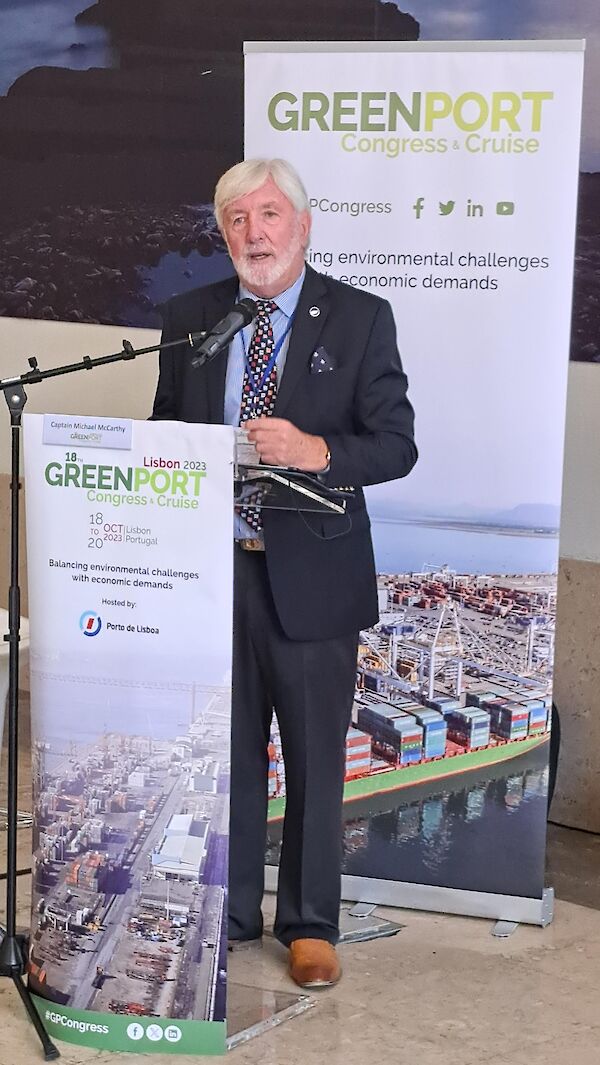Cruise Europe chairman moderates sessions at GreenPort Congress & Cruise in Lisbon
 The Port of Lisbon hosted the 18th edition of GreenPort Congress & Cruise from October 18 to 20. Cruise Europe (CE) chairman Captain Michael McCarthy was honoured to moderate two of the sessions: Cruise Infrastructure Development and Shore Power.
The Port of Lisbon hosted the 18th edition of GreenPort Congress & Cruise from October 18 to 20. Cruise Europe (CE) chairman Captain Michael McCarthy was honoured to moderate two of the sessions: Cruise Infrastructure Development and Shore Power.
In the first session, Duarte Morais Cabral, general manager Lisbon Cruise Port, presented ‘Going Green: How can a Cruise Terminal be more sustainable’. He highlighted the importance of terminals playing an important role within the community by implementing eco-friendly practices like using renewable energy sources, optimising waste management, promoting local and sustainable tourism, and adopting technologies to reduce emissions and environmental impact.
Minas Papadakis, CEO, Heraklion Port Authority outlined the major way that ports can contribute to reducing shipping’s emissions. He explained how the administration of Heraklion Port has set the green transition as its top priority, and that the European programme – Electriport – was the result of its efforts towards a greener and sustainable port.
He was followed by Armando Santos, global partner-client manager of Quadrant, who spoke about the targets for reducing the carbon footprint of the port operation and its impact on Lisbon City and the implementation of OPS systems on the Cruise and Cargo Terminals of the Lisbon Port Oriental area.
Finally Stephen Xuereb, COO, Global Ports Holding outlined the company’s remarkable expansion in transforming cruise infrastructure and its commitment to developing future-ready ports and shaping the cruise infrastructure of tomorrow.
To commence the session on onshore power, Olivier Teramo, key accounts manager, head of projects, ABB Global, presented on the use of renewable energy sources at ports supporting the shore connection. He outlined how different shore connection applications will ultimately play a big role in decarbonising the marine and ports industries. He presented to the audience a case example of Port of Toulon, one of ABB’s project deliveries, which is utilising energy storage as part of shore connection.
Posing the question ‘What kind of options do ports have in their carbon neutrality journey?’, Laurent Dupuis, VP global product manager ports & maritime, Cavotec, outlined his role in piloting the business strategy and the product roadmap for the company’s shore power, and e-vessels charging solutions. He compared the emissions reduction potential of different solutions for several ports and terminal types (cruise, ferries, container) to shed some light on how ports can create the best journey towards carbon neutrality.
Michaela O’Donohoe who leads business development for Microgrid Solutions business at GE Vernova, explored the reliability aspects of large power converter (range between 5MVA and 20MVA), based on more than 30 years of return of experience on critical electrical systems.
As head of sales at PowerCon, Jacob Bjarkam is part of his company’s green transition towards a better future which enables ships to eliminate all emissions when in port. He outlined his role in building an entire industry from the ground up, explaining that when PowerCon first started working with shore power, there was great scepticism from both ports and shipping companies.
Today, this scepticism has turned into a unified maritime ambition to ensure a sustainable future, where shore power plays a central role. He outlined how fortunate he has been to be part of many successful shore power projects in ports such as Kristiansand, Southampton, Barcelona, Hamburg, Oslo and Miami.
McCarthy says: “As chairman of Cruise Europe, I found the two sessions to be most informative and very interesting to moderate. I was left with the following takeaways:
When considering OPS, ports need to look at the long-term benefits model combining CAPEX and OPEX over a very long potential profitability rate; the long-term cost of power generated on board versus shore power; the debate over ‘future vessels with zero carbon fuels versus OPS’ when considering the source of power; the ‘Who Pays’ principal; building sub-stations on quays; the model of ‘Who provides the power to the ship… the port or the generating company?’; the potential of a subsidised system; the diversity of ships and the power requirements across the whole shipping sector; and the TEN-T [Trans-European Transport Network] targets for shoreside electricity supply in maritime ports.”
And last but not least, a very bold statement of ambition from Papadakis: “ Our mission is no emissions”.
(Cruise Europe chairman moderates sessions at GreenPort Congress & Cruise in Lisbon – Cruise Europe)



